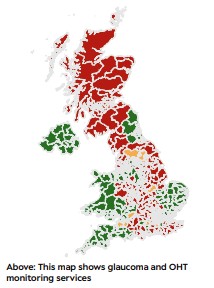Unlocking the full potential of optometry to support the NHS
Community optometrists are playing a vital role in reducing demand on the NHS – and can do more.
A new Specsavers report highlights that community glaucoma services, when commissioned, can cut hospital eye visits by roughly 50%, potentially freeing up 300,000 hospital appointments in England if available nationwide.
A 'clear opportunity'
Glaucoma Enhanced Referral Services (GERS), for example, enables optometrists with additional glaucoma accreditation to review suspected cases from other optometrists.
Primary Eyecare Services has seen more than 14,000 patients in four years through GERS in local optometry practices – with half discharged safely into the community, saving 7,000 hospital appointments.
Tom Mackley, glaucoma clinical lead at Primary Eyecare Services, notes: ‘There’s a clear opportunity to expand GERS with effectively commissioned services throughout all areas of England.’
Collaboration delivering benefits
Professor Roshini Sanders, Consultant Ophthalmologist, is also a contributor to the report. ‘I lead an integrated service across primary and secondary care,’ she says.

‘Community optometrists now independently see low risk glaucoma patients and those who have completed treatment. They have virtual support for unstable cases. This has created significant capacity for timely care of high-risk patients within the NHS.’
Nishani Amerasinghe, Consultant Ophthalmologist, further writes that prevalence of major eye conditions is expected to grow by 25% by 2032, seven times faster than overall population growth.
‘When it comes to glaucoma, the optometrist is our gatekeeper because 50% of glaucoma is undiagnosed. It must be detected and treated early to prevent sight loss,’ she says.

Gaps in England’s commissioning of NHS eye care
Despite the success of enhanced eye care services in many areas, gaps persist in England. Five Integrated Care Boards (ICBs) are yet to commission any NHS glaucoma referral or refinement service, and 13 have no NHS community-based monitoring.
This is in spite of evidence suggesting up to 70% of eye-related A&E cases could be effectively managed outside hospital settings through community-based optometry.
Wales: a model of innovation in eye care
The report explores progressive approaches in Wales, where new care pathways and independent prescribing by optometrists are enabling more treatment to take place outside hospitals.
The focus is on optimising both primary care optometry and secondary care ophthalmology resources to improve patient access and outcomes, ultimately aiming to reduce chronic disease risk.
As David O’Sullivan, chief optometric advisor for the Welsh Government, explains: ‘Community optometrists are now embedded within the system of healthcare providers to “make every contact count” to promote prevention and wellbeing advice to patients.’
Scotland: Reducing hospital visits and expanding access
Scotland’s approach sees around 350,000 hospital visits avoided each year, through NESGAT training and the qualification of optometrists in independent prescribing.
These professionals can now prescribe medication and treat glaucoma patients discharged from hospital, an approach especially beneficial in rural communities with limited access to hospital-based services.
Andrew Tatham, consultant ophthalmologist with NHS Lothian and NHS Scotland, and President of the UK and Eire Glaucoma Society, says: ‘Collaborative working between the hospital eye services and community-based optometrists who have advanced clinical training helps avoid unnecessary referrals.’
 Northern Ireland: fostering collaboration for better outcomes
Northern Ireland: fostering collaboration for better outcomes
Northern Ireland is also prioritising collaborative care, with optometrists and ophthalmologists working together to manage glaucoma and ocular hypertension within the community.
England: embrace change
The report argues that, if England were to adopt similar models, the benefits could be substantial. Giles Edmonds, clinical services director at Specsavers, says: ‘If England adopted these models, more than 600,000 GP and A&E appointments could shift to local optometry practices.’
The evidence from across the UK highlights the transformative impact of empowering community optometrists—helping to reduce hospital pressures, improve outcomes for patients, and ensure the NHS remains fit for the future.
Read the full report now at specsavers.co.uk/reports/access-to-care-2025.
